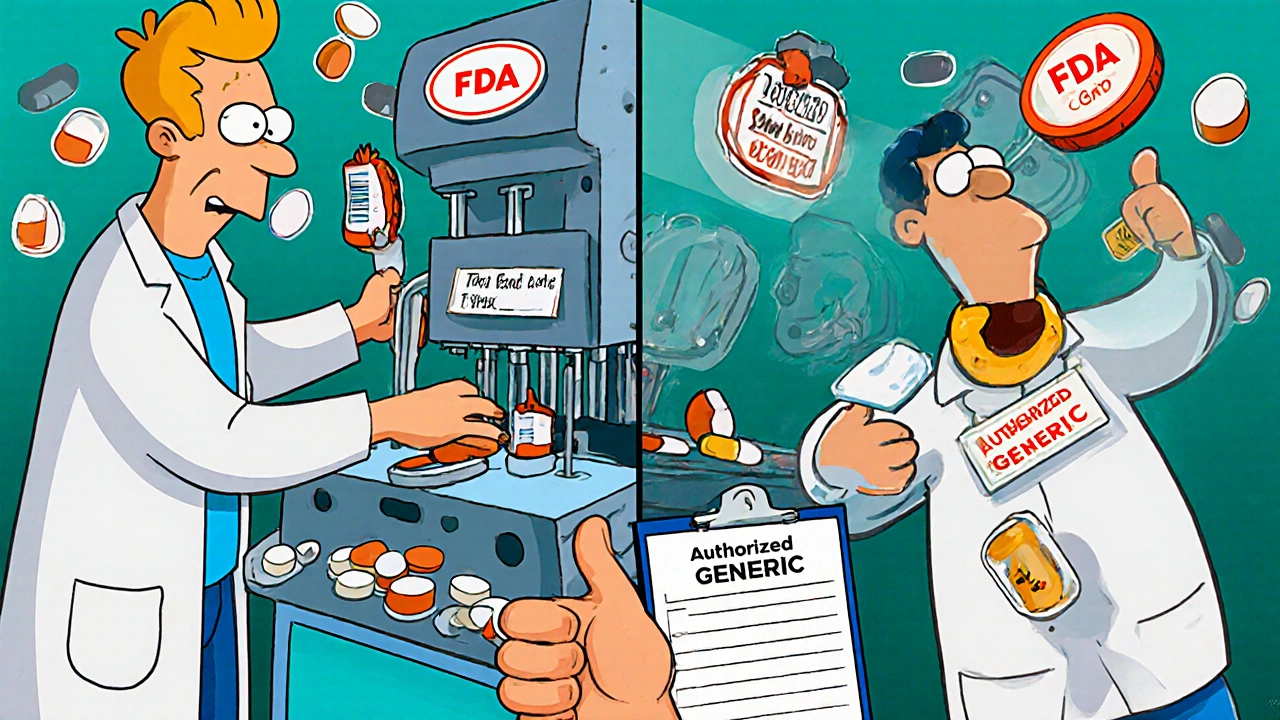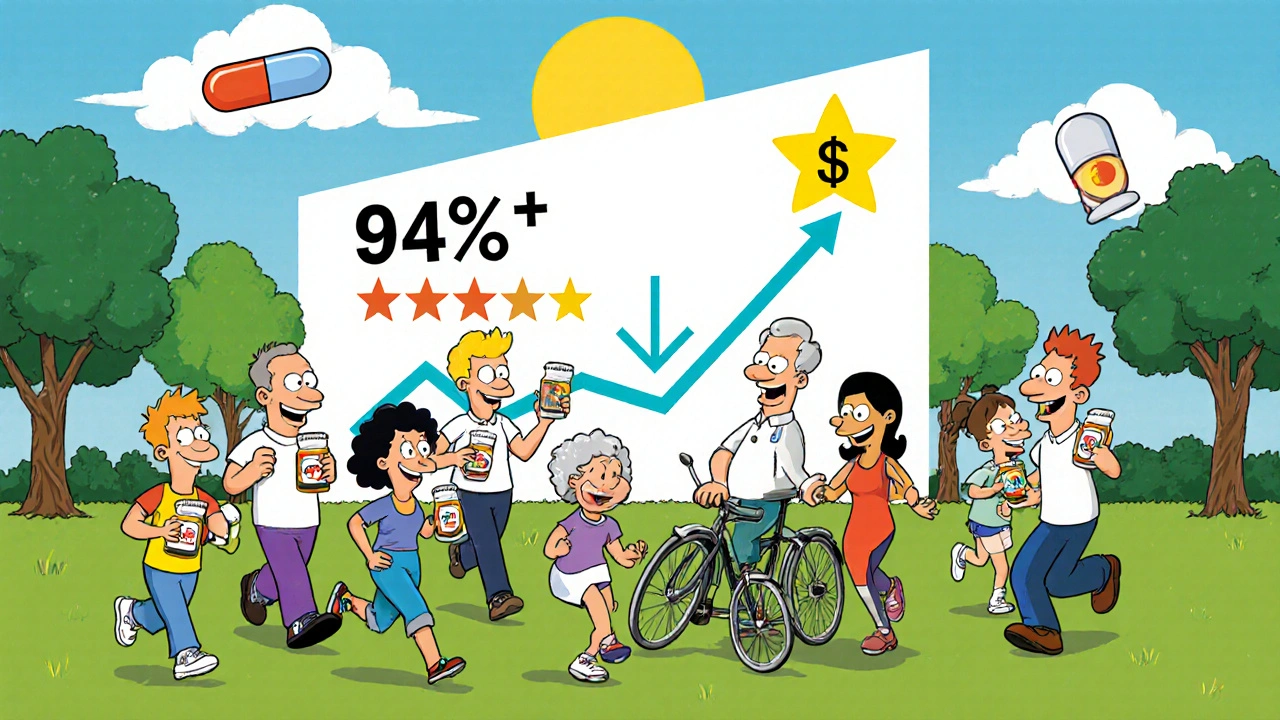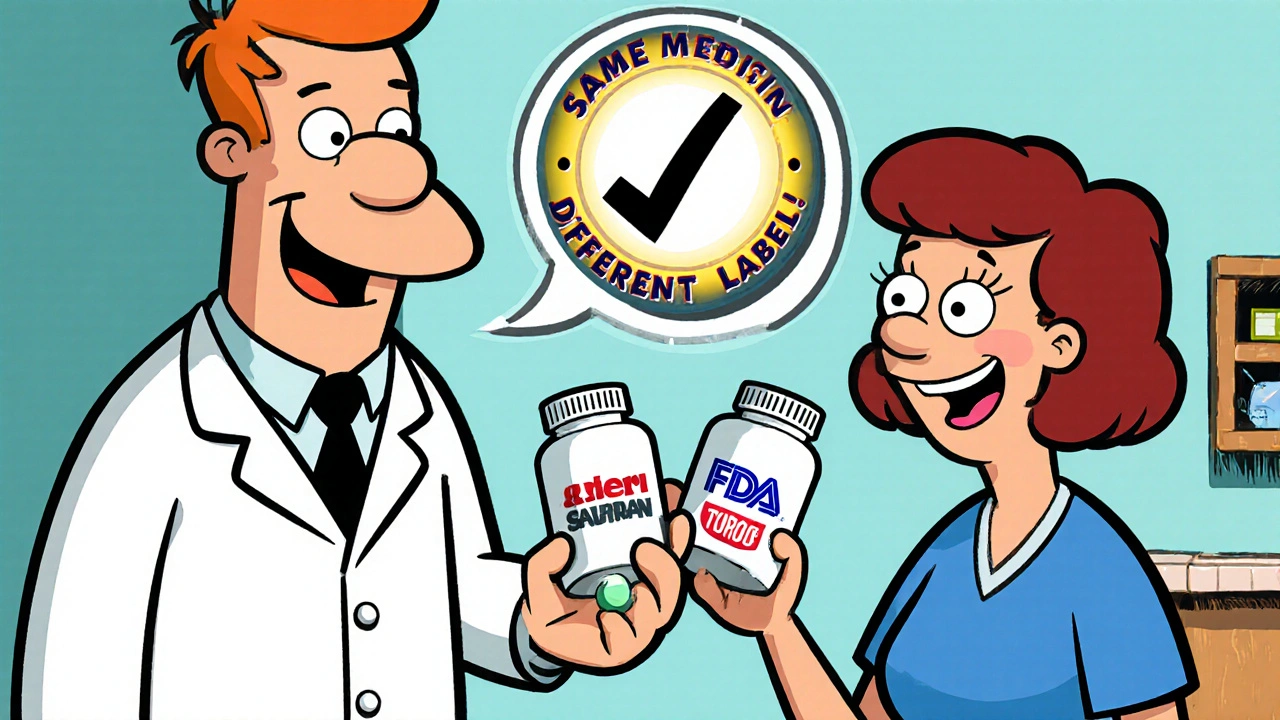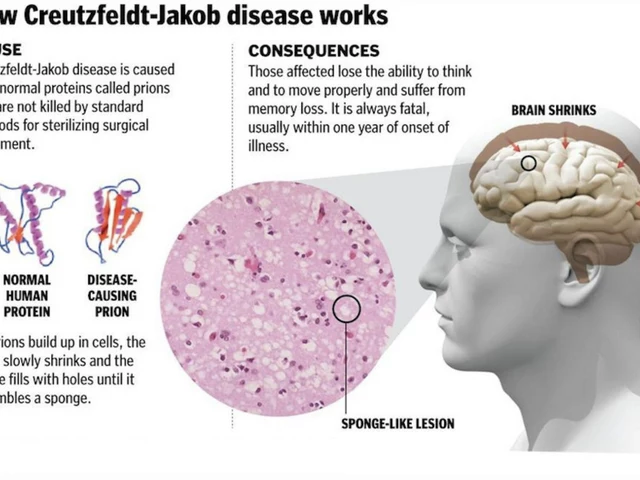When you walk into a pharmacy and see two pills that look almost identical-one with a familiar brand name, the other plain and cheaper-you might wonder: is the cheaper one really the same? This isn’t just a question about price. It’s about safety, effectiveness, and trust. If you’ve been taking a brand-name drug for years and your doctor or pharmacist switches you to an authorized generic, you’re not being handed a lesser version. You’re getting the exact same medicine, just without the brand logo on the bottle.
What Exactly Is an Authorized Generic?
An authorized generic isn’t just another generic drug. It’s the brand-name drug, made in the same factory, with the same ingredients, using the same process, but sold without the brand name on the label. The U.S. Food and Drug Administration (FDA) says it plainly: an authorized generic is the brand drug, minus the branding. No changes. No shortcuts. No compromises. Unlike traditional generics, which go through a separate approval process to prove they work the same way, authorized generics don’t need to prove bioequivalence. Why? Because they’re not different to begin with. They’re made under the original brand’s New Drug Application (NDA). That means the same batch of active ingredient, the same fillers, the same coating, the same tablet press. The only thing that changes is the label. This isn’t a loophole. It’s a regulatory feature. The Hatch-Waxman Act of 1984 created the framework for generic drugs, but authorized generics emerged later as a business strategy. Brand companies, facing patent expiration, started making their own generic versions to stay in the market. That’s not shady-it’s smart. And it means you get the same drug, often at a lower price, without risking quality.How Do Authorized Generics Compare to Traditional Generics?
Traditional generics are required to match the brand-name drug in strength, dosage, and how fast the drug enters your bloodstream. The FDA demands that their absorption rates fall within 80-125% of the brand’s. That’s a wide range. For most people, it’s perfectly safe. But for some-especially those on narrow-therapeutic-index drugs like warfarin or thyroid meds-even small differences can matter. Authorized generics don’t have that uncertainty. They’re not just close. They’re identical. The same active ingredient. The same inactive ingredients. The same manufacturing line. The same quality control checks. If your brand-name drug came from a specific lot number, the authorized generic from the same company comes from the exact same lot. You’re not switching from one product to another. You’re switching from one label to another. A 2018 study in the Journal of the American Medical Informatics Association tracked over 5,000 patients who switched from brand-name drugs to generics. Those who switched to authorized generics had outcomes nearly identical to those who stayed on the brand. The same number of hospital visits. The same rate of medication adherence. The same level of symptom control. Even the slight uptick in emergency room visits seen with authorized generics was so small-just 8% higher-it was likely due to confusion at the pharmacy, not the drug itself.Are Authorized Generics as Safe as Brand-Name Drugs?
Safety isn’t a guess. It’s measured. The FDA inspects the manufacturing facilities of brand-name drugs and authorized generics the same way. Both must follow Current Good Manufacturing Practices (cGMP). Both are subject to the same recalls. Both must report adverse events under the same system. In 2022, the FDA clarified that authorized generics must maintain the same lot traceability as their branded counterparts. That means if there’s a problem with a batch, the agency can track it back to the exact production run-no matter if it’s labeled as brand or generic. This isn’t just paperwork. It’s patient safety. Some patients report feeling different when switching to generics. But in most cases, it’s not the drug. It’s the pill’s color, size, or shape. Or the way the bottle opens. Or the new pharmacy staff who don’t know the difference. One patient on Reddit said they thought their authorized generic for Singulair wasn’t working because the pill was white instead of blue. It was the same medicine. Just a different look. A survey by the Asthma and Allergy Foundation of America found that 87% of users reported no difference in effectiveness when switching from brand-name Singulair to its authorized generic. Only 8% noticed minor issues-and those were tied to packaging, not the drug.
Why Do Authorized Generics Cost More Than Traditional Generics?
If authorized generics are identical to brand-name drugs, why aren’t they the cheapest option? Because they’re not competing with traditional generics the same way. Traditional generics are made by separate companies. Once a patent expires, dozens of manufacturers can jump in. Competition drives prices down-sometimes to pennies per pill. Authorized generics are made by the original brand company. They’re not trying to undercut the market. They’re trying to keep their share of it. So they price them lower than the brand, but higher than the generic. Typically, you’ll pay 15-30% less than the brand, but 10-20% more than a traditional generic. That’s still a savings. And if your insurance covers authorized generics at the same tier as traditional generics, your copay might be the same. Some insurers even prefer them because they’re less likely to cause switching issues.What Do Experts Say?
Dr. Janet Woodcock, former head of the FDA’s drug evaluation center, said it clearly: “Authorized generics are the brand product without the brand name on the label-they are identical in every way.” Dr. Aaron Kesselheim, a Harvard professor who led a major study on generic drug outcomes, called authorized generics the “ideal comparator” for brand-name drugs. Why? Because they eliminate the variables. If you want to know whether a generic works as well as a brand, test it against the authorized version. That’s the cleanest test possible. The American College of Clinical Pharmacy confirms this. Their official position: authorized generics are therapeutically equivalent to brand-name drugs because they are the same drug product. Some experts warn that the proliferation of generic options can confuse pharmacists and patients. But that’s a system problem-not a product problem. The drug itself? It’s unchanged.
Real-World Data: Do People Actually Benefit?
Kaiser Permanente tracked over 8,000 patients using authorized generics. Their adherence rate? 94%. That’s higher than the 92% seen with brand-name drugs. Why? Because patients were more likely to fill their prescriptions when the cost dropped. GoodRx reviews of 37 authorized generics show an average rating of 4.6 out of 5.0. Ninety-two percent of users said they’d recommend them to a friend. And here’s the kicker: in 2022, the U.S. market for authorized generics hit $18.7 billion. That’s not a fluke. It’s demand. People are choosing them because they work. And they’re saving money while doing it.How to Know If You’re Getting an Authorized Generic
Not all generics are created equal. So how do you tell if you’re getting an authorized version? Ask your pharmacist. They can check the label. Authorized generics will often say “Manufactured for [Brand Name]” or “Distributed by [Brand Name]”. Sometimes they’ll have the same imprint code as the brand pill. If you’re unsure, ask: “Is this the same as the brand?” You can also check the FDA’s website. While authorized generics don’t appear in the Orange Book (because they’re under the brand’s NDA), you can search for your drug and see if the brand company lists an authorized version. Most importantly: if you’ve been on a brand-name drug for a long time and your pharmacy switches you to a generic, don’t assume it’s an authorized one. Ask. Confirm. Make sure you know what you’re getting.Bottom Line: You’re Not Compromising
Choosing an authorized generic isn’t settling. It’s smart. You’re getting the exact same drug your doctor prescribed, at a lower cost, with no loss in quality, safety, or effectiveness. The science is clear. The data backs it up. The experts agree. If you’re worried about switching, talk to your doctor or pharmacist. But don’t let fear of the unknown stop you from saving money. The pill in your hand? It’s the same one you’ve always taken. Just without the price tag that comes with a famous name.Are authorized generics the same as brand-name drugs?
Yes. Authorized generics are identical to their brand-name counterparts in active and inactive ingredients, strength, dosage form, and manufacturing process. The only difference is the label-they don’t carry the brand name. The FDA confirms they are the exact same drug product.
Why are authorized generics more expensive than traditional generics?
Authorized generics are made by the original brand company, so they don’t face the same level of competition as traditional generics made by multiple manufacturers. They’re priced lower than the brand but higher than traditional generics-usually 15-30% cheaper than the brand and 10-20% more than a traditional generic.
Can I trust authorized generics for chronic conditions like high blood pressure or diabetes?
Absolutely. Authorized generics are subject to the same FDA quality controls and manufacturing standards as brand-name drugs. Studies tracking patients with chronic conditions show no meaningful difference in effectiveness, hospital visits, or medication adherence between authorized generics and their brand-name versions.
Do authorized generics have the same side effects as brand-name drugs?
Yes. Since they contain the same ingredients and are made in the same facility, authorized generics produce the same side effects as the brand-name version. Any reported differences are usually due to changes in pill appearance, packaging, or psychological factors-not the drug itself.
How do I know if my prescription is an authorized generic?
Ask your pharmacist. Authorized generics often say “Manufactured for [Brand Name]” on the label or have the same imprint code as the brand pill. You can also check the manufacturer’s website or ask if it’s made by the original brand company. If in doubt, request clarification before filling.
Will my insurance cover authorized generics the same as brand-name drugs?
Most insurance plans cover authorized generics at the same tier as traditional generics, meaning lower copays than brand-name drugs. Some plans even prefer them because they reduce switching issues. Always check your formulary or call your insurer to confirm coverage.




